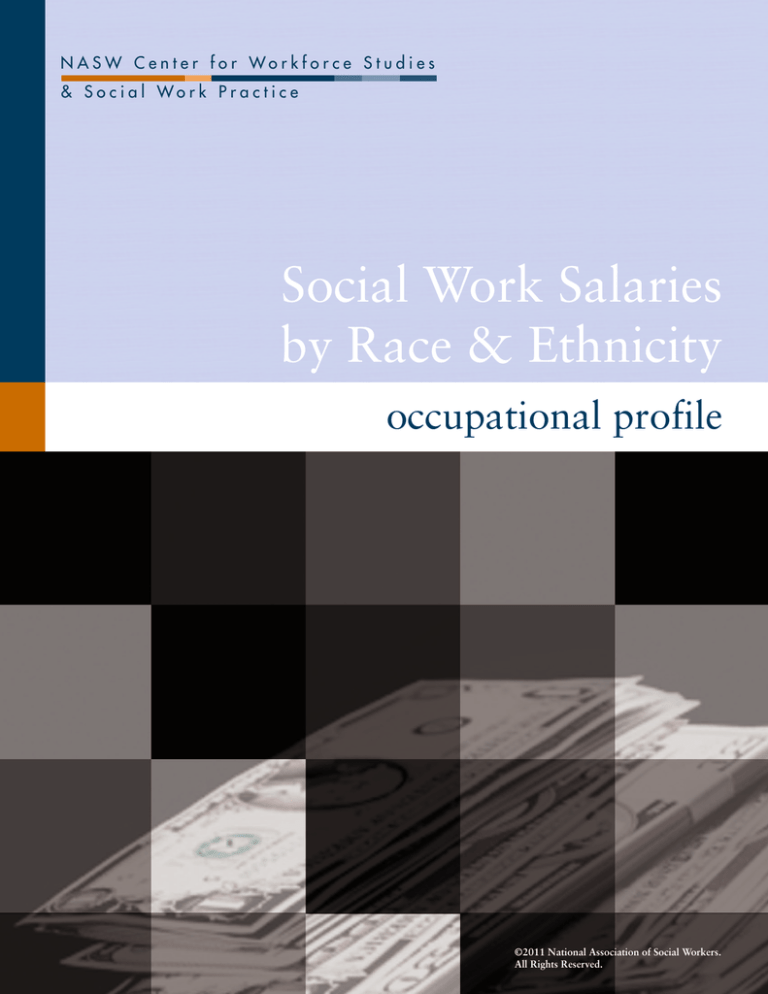
N A S W C e n t e r f o r Wo r k f o r c e S t u d i e s
& S o c i a l Wo r k P r a c t i c e
Social Work Salaries
by Race & Ethnicity
occupational profile
©2011 National Association of Social Workers.
All Rights Reserved.
Overview
The population of the United States is increasing and by the year 2050, it is expected to have grown to 394 million
people—of which 54 percent will be comprised of minorities (U.S. Census Bureau, 2008). More significant to this increase
in the nation’s population are the demographic changes that indicate that the U.S. foreign-born population will continue to
grow and comprise a larger segment of the overall population. As a result of this demographic shift, the populace will
reflect increasingly significant ethnic and racial diversity.
The American population is experiencing major changes that will affect the social work workforce, their clients, agencies,
communities and service delivery systems. For instance, data show an increase in persons who reported they speak a
language other than English at home and who have difficulty speaking English (Webb, 2010). The issues of cultural
competence and limited English proficiency (LEP) contribute to efforts to address racial and ethnic disparities in health,
mental health, and education status and the disproportionate confinement in restrictive settings in the child welfare,
juvenile justice and criminal justice systems (Social Work Speaks, 2009).
occupational profile
In order to respond to the current and projected demographic changes in the United States, the social work workforce
can be instrumental in addressing issues of racial and ethnic diversity across the life span. Although the majority of social
workers are White/Caucasian, the demographics of the client population with whom social workers work fall within the
broad category of disenfranchised populations including a disproportionate number of people of color (Gilberman, 2005;
Whitaker, Clark & Weismiller, 2006). The discrepancy between the composition of the social work labor force and the
demographic profile of many client groups, led the profession to identify and emphasize the need for social workers to
develop competence in culturally and ethnic competence practice (Gilberman, 2005). In addition to promoting cultural
competency practice, the federal government is supporting the health and mental health workforce to increase diversity
where there is a short supply. For instance, African Americans, Hispanics and Native Americans are significantly
underrepresented in the health and mental health workforce (Health Resource and Service Administration, 2007).
According to the Bureau of Labor Statistics, employment for social workers is expected to grow at a significant rate (BLS,
2010-2011). It is likely that with the projected racial and ethnic demographic shift across the life span and the continual
need for diversity within the workforce, the social work profession will offer great employment opportunities. In addition,
because of the underrepresentation of social workers of color within the profession there is the increased likelihood that
practitioners who are prepared to provide services to and motivated to work with diverse populations will find
employment opportunities.
REFERENCES
Gilbelman, M. (2005). What social workers do (2nd ed.). Washington DC: NASW Press.
National Association Social Workers. (2010). Cultural and linguistic competence in the social work profession. In social
work speaks: National Association of Social Workers policy statements, 2009-2012 (8th ed., pp. 70-76). Washington,
DC: Author.
U.S. Census Bureau News. (2008, August 14). An older and more diverse nation by midcentury. [Press release].
Retrieved from: www.census.gov/Press-Release/www/releases/archives/population/012496.html
U.S. Bureau of Labor Statistics. (2010-2011). Occupational outlook handbook, social work. Retrieved from:
www.bls.gov/oco/ocos060.htm
1
U.S. Health and Human Services, Health Resource Services Administration, 2007. Health Professions. Retrieved from:
www.hrsa.gov
Webb, R. (June 2010). Social workers: a bridge to language access services. NASW Practice Update.
Washington, DC: National Association of Social Workers.
Whitaker, T. Clark, E. & Weismiller, T. (2006). Assuring the sufficiency of a frontline workforce: A national study of
licensed social workers. Executive summary. Washington, DC: National Association of Social Workers.
Data referenced in this profile are based upon results from the 2009 NASW Salary & Compensation Study (see Notes).
Annual Salary Breakdown
SUMMARY OF PARTICIPANTS1
Social Work Salaries by Race & Ethnicity
1
The small number of participants in the Asian/Pacific Islander, Native American/Alaskan Native and Multiracial categories prohibited further
analysis of these participants.
2
SALARY BREAKDOWN
ANNUAL SALARY BY RACE2
occupational profile
Annual Salary by Census Region3 and Race/Ethnicity
NORTHEAST
ANNUAL SALARY/NEW ENGLAND
2
Which one of the following categories best describes your race or ethnicity? Please check only one option.
On October 1, 2009, what was the city, state, and ZIP code of your primary work location?
The Census Bureau Regions are: New England (Connecticut, Maine, Massachusetts, New Hampshire, Rhode Island, Vermont); Middle
Atlantic (New Jersey, New York, Pennsylvania); East North Central (Indiana, Illinois, Michigan, Ohio, Wisconsin); West North Central
(Iowa, Kansas, Minnesota, Missouri, Nebraska, North Dakota, South Dakota); South Atlantic (Delaware, District of Columbia, Florida,
Georgia, Maryland, North Carolina, South Carolina, Virginia, West Virginia); East South Central (Alabama, Kentucky, Mississippi,
Tennessee); West South Central (Arkansas, Louisiana, Oklahoma, Texas); Mountain(Arizona, Colorado, Idaho, New Mexico, Montana,
Utah, Nevada, Wyoming); and Pacific (Alaska, California, Hawaii, Oregon, Washington).
3
3
ANNUAL SALARY/MIDDLE ATLANTIC
Social Work Salaries by Race & Ethnicity
MIDWEST
ANNUAL SALARY/EAST NORTH CENTRAL
4
ANNUAL SALARY/WEST NORTH CENTRAL
occupational profile
5
SOUTH
ANNUAL SALARY/SOUTH ATLANTIC
ANNUAL SALARY/EAST SOUTH CENTRAL
ANNUAL SALARY/WEST SOUTH CENTRAL
Social Work Salaries by Race & Ethnicity
6
WEST
ANNUAL SALARY/MOUNTAIN
occupational profile
7
ANNUAL SALARY/PACIFIC
ANNUAL SALARY BY PRACTICE AREA
PRIVATE PRACTICE: SOLO
Social Work Salaries by Race & Ethnicity
PRIVATE PRACTICE: GROUP
8
N A S W C e n t e r f o r Wo r k f o r c e S t u d i e s
MENTAL HEALTH CLINIC/OUTPATIENT FACILITY
HOSPITAL/MEDICAL CENTER
occupational profile
9
SCHOOL (K-12)
SOCIAL SERVICE AGENCY
Social Work Salaries by Race & Ethnicity
10
N A S W C e n t e r f o r Wo r k f o r c e S t u d i e s
HOSPICE/PALLIATIVE CARE
COLLEGE/UNIVERSITY
occupational profile
11
HEALTH CLINIC/OUTPATIENT FACILITY
GOVERNMENT AGENCY
Social Work Salaries by Race & Ethnicity
12
N A S W C e n t e r f o r Wo r k f o r c e S t u d i e s
PSYCHIATRIC HOSPITAL
occupational profile
13
Survey Methodology
This survey was sponsored and developed by NASW. Data was collected and tabulated by Readex Research, an
independent research company. To broaden representation of the profession, NASW partnered with a number of other
social work membership organizations to create an expanded list of U.S. professional social workers for sampling
purposes. These partner organizations were:
■
Association for Oncology Social Work (AOSW)
■
National Hospice & Palliative Care Organization (NHPCO)
■
National Network for Social Worker Managers (NNSWM)
■
The Rural Social Work Caucus
■
Society for Social Work Leadership in Health Care (SSWLHC)
The total number of unduplicated individuals among these five lists and the NASW domestic membership was 101,995.
The overall sample size of 78,777 consisted of the 73,777 with a valid email address on file and a systematic sample
of 5,000 (among the 28,218) who could not be reached via email.
Data was collected between October 1 and November 24, 2009. A total of 23,889 unduplicated usable responses
were received, for a 30% response rate. Among these, 22,000 responses were randomly chosen for inclusion in the
final tabulation. The data has been weighted to account for disproportional response between the email and regular mail
samples. Percentages based on all 22,000 responses are subject to a margin of error of ±0.6%.
RESPONDENT STATUS
The compensation analysis focuses on the subset of “valid answering practitioners” – that is, U.S.-based respondents
confirming paid employment or self-employment on October 1, 2009 in a social work-related position (that is, any position
that requires or makes use of one’s education, training, or experience in social work), and reporting regular salary or
wages. Percentages based on these 17,851 “valid answering practitioners” are subject to a margin of error of ±0.6%.
Removed are those who did not answer at all, those who provided a report considered to be an outlier (top 1% and
bottom 1% of all responses), and those who did not answer in a coherent manner. The tabulated base of the “answering
practitioners” is 17,911. The results are not shown if there are fewer than 30 valid values in a category.
Social Work Salaries by Race & Ethnicity
Data collection utilized a mixed mode approach. For those with a valid email address, invitations were sent via email to
access a web-based survey. Those without an email address were sent invitations via regular mail, with the option to fill
out a provided paper survey or to access the survey online via a provided web site address.
14
NASW
National Association of Social Workers
750 First Street NE, Suite 700
Washington, DC 20002-4241








